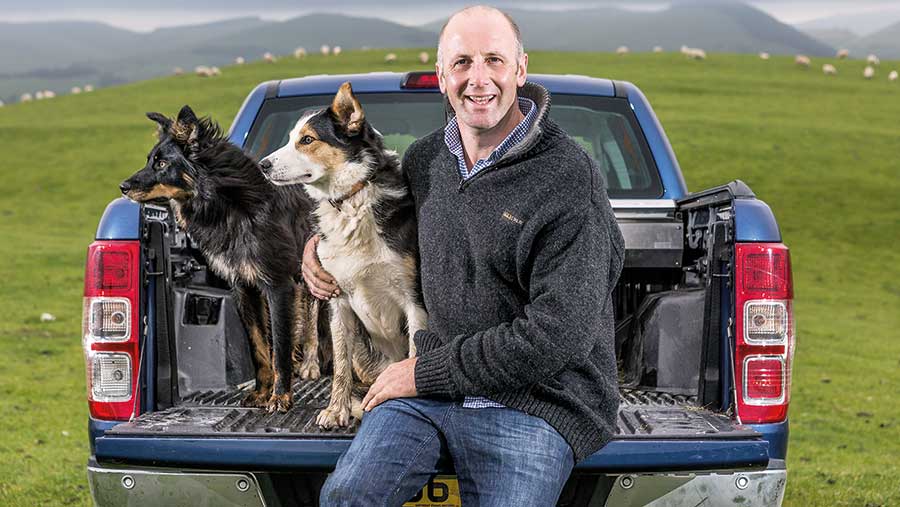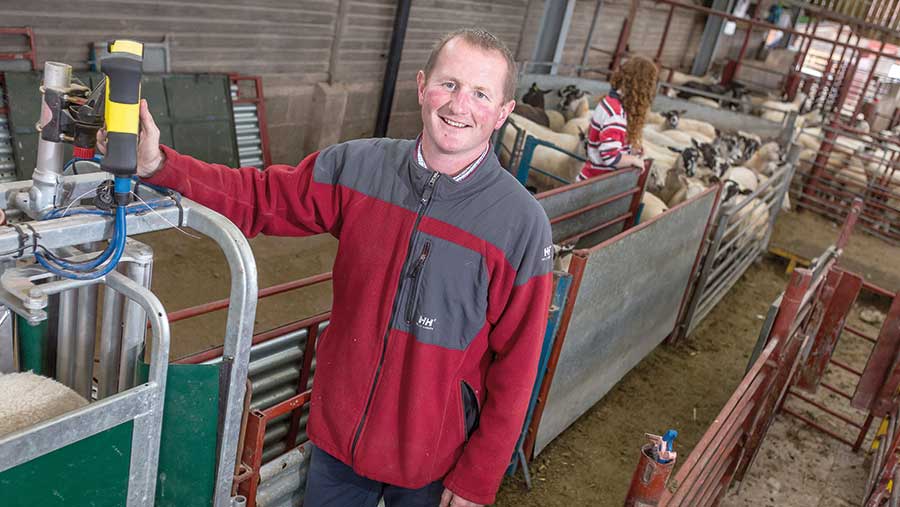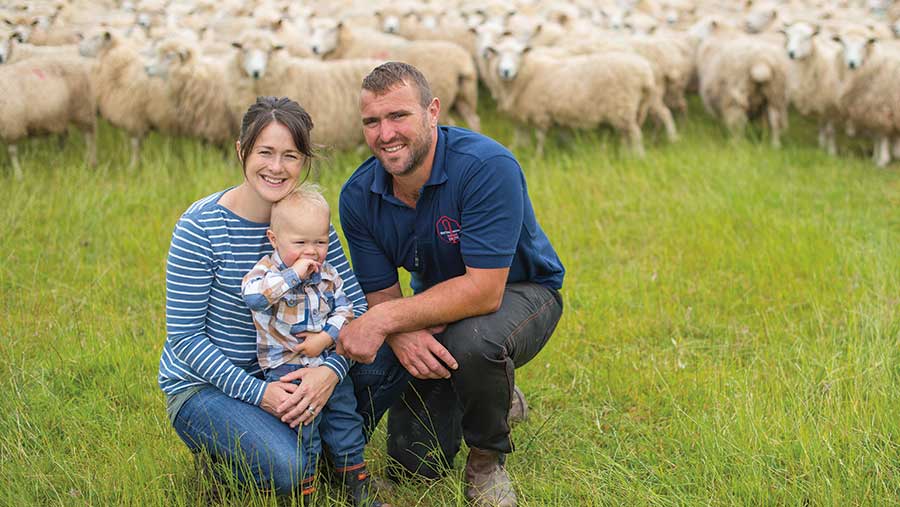2017 FW Awards: Sheep Farmer of the Year finalists
The Farmers Weekly Awards 2017 finalists have been announced and the judges have visited each of the finalists for a three-hour interview and tour.
These finalists are great producers who have all fine-tuned different systems designed to suit their personal, climactic and geographical circumstances to leave both a margin and a desirable carcass for the market.
See also: Book your table for the 2017 Farmers Weekly Awards night
- Dafydd Jones, Maesllwyni, Penegoes, Machynlleth, Powys
- Sam Jones, Redditch, Worcestershire
- Matt and Pip Smith, Trefranck, St Clether, Cornwall
The judges:
- Gordon Wyeth, the 2016 Farmers Weekly Awards Sheep Farmer of the Year
- Michael Priestley, Farmer Weekly Livestock reporter
- John Vipond, independent judge
Dafydd Jones, Maesllwyni, Penegoes, Machynlleth, Powys

Dafydd Jones © Richard Stanton
Economics
Farm facts
- Mixed flock of 750 ewes and 70 Limousin-cross beef cows put to a Hereford bull to finish all cattle mostly on grass/clovers
- Supplying Dalehead Foods for Waitrose for 15 years
- Land rising from 60m to 304m above sea level
- Cows weigh 600-650kg, sheep 60-65kg, 180 effective ha
- Scanning 150%, rearing 135%
Integrating hybrid cattle and sheep and monitoring soil health has ensured Dafydd Jones can cost-effectively finish 800 lambs each year, of which 772 hit specification.
When combined with 18-20% crude protein, 11 metabolisable energy clover silages the result is an efficient system that has propelled a failing upland grass farm in the early 1990s, into a showcase farm for the Welsh sheep industry.
The farm, which was bought by the Jones family in 1994, is running a medium output system, content to scan at 150-160% and rearing 135%.
Each year the farm breeds 200 replacements.
No concentrates have been bought in for the sheep operation in three years, largely thanks to grazing management and producing high-quality red and white clover silages.
This has helped the one-man operation decrease total cost of production to below £3/kg deadweight (292p/kg).
All-grass wintering moderately sized 65kg ewes bred from Improved Welsh Mountain-cross Texels further controls costs.
Composite sires have been used since 2009 and performance-recorded Innovis tups since 2013.
Farm income is boosted by maximising prices for lambs through an organic premium and hitting Waitrose specification (E, U, R at 2-3L) 96.5% of the time.
Lambs are weaned at about 16 weeks of age after a March 1 lambing, with lambs sold from June to early October and 50% gone by the end of July.
Environment
An organic mindset has been complimented through woodland creation and entry-level Glastir work, which has seen 22,000 native trees planted, streamside corridors fenced off and shelter belts provided to aid winter grazing.
Rainwater is harvested, while solar panels supply the farmhouse with electricity.
Soil testing reviews pH, lime, phosphate, potash and magnesium levels every three to four years to keep pH level above 6.
Health
Minimising medicine and antibiotics usage is key. Wormers are only used following faecal eggs counts and veterinary advice, with chicory included in mixed species leys too.
“We need to know what parasites are there to dose accordingly” explains Mr Jones. “If you test, then sometimes you don’t need to dose in a good year.”
The judges liked
- Moderate stocking at 3.0 ewes/acre (1.4 livestock units/ha)
- Harvesting rainwater and saving money through water tank system
- Up to 95% of lambs hitting specification
- Infrared cameras improve lambing shed efficiency
- Biosecurity improving with developing woodland corridors
Sam Jones, Redditch, Worcestershire

Sam Jones © Richard Stanton
Economics
Farm facts
- 202ha of which 80ha rented
- 53ha arable 20ha grass leys 129ha permanent grass leys
- 1,150 North of England Mules
- Growing barley, wheat and oats at 9.5t/ha
- Supplying Farmers Fresh in Kenilworth
- Lambs sent at 43-45kg liveweight (21kg carcass)
- Using EBVs for growth traits
Scaling back flock size at Brookhouse Farm from 2,000 to 1,150 has lifted rearing rates by around 23% in 10 years.
The smaller flock has also eased disease pressure. Orf and coccidiosis have been eradicated, which has cut veterinary bills 30% and is making flock management less labour intensive.
Meanwhile, electronic identification is informing stock buying decisions by tracing back the best performing lambs to certain mule breeders.
Costs of production have been tightened to £66 a lamb through a number of measures including feeding home-grown cereal, investing time in developing student vets at lambing and installing a biomass boiler and solar panels.
In addition, lambs and yearling ewes are being fed for 21% less using a three-in-one feeder, which enables ewes to eat unprocessed barley by licking it. The ration is worth an extra 100g in daily liveweight gain.
As another income stream, the farm’s strong commercial focus has attracted good demand for its breeding ewes.
About 850 Texel-cross breeding ewe lambs are sold off farm.
Environment
A total of 1,690kW of power is generated between solar panels and the boilers. Biomass boilers generate heating and electricity to dry bedding and grain and keep business units warm in the farm year.
Various woodland projects have been continued despite coming out of Entry Level Stewardship schemes.
Double fencing hedges has been started in order to offer protection from grazing livestock and nurture nesting birds.
Health
Animal health and welfare is addressed in a “prevention is better than cure” approach. This sees condition scoring and ewe weight analysis of sheep at tupping and housing, surgical spirit used to clean equipment between each pen of stock and staff foot disinfection practised between lambing sheds to stop disease transmission.
Recent improvements include use of a sheep spray system for flies as opposed to a pour-on production.
This has saved £6,000 in labour and products and is reducing fly strike from 1% to only two cases last year.
“Making sure sheep farming is profitable and sustainable is our continued goal for the next generation,” says Mr Jones.
The judges liked
- Good technical performance rearing close to 190%
- Training vets and managing teams at busy periods on the farm
- Putting weight on yearling ewes with three-in-one feeder
- Measuring and performance recording
- Stamped out orf and coccidiosis
Matt and Pip Smith, Trefranck, St Clether, Cornwall

Matt and Pip Smith with son Dusty © Jim Wileman
Economics
Farm facts
- 1,000 Romney ewes and 240-head deer herd on 121ha
- 88% of lambs in specification
- Contract supplying Randall Parker and Waitrose
- Produces 19-21kg carcass at R3L
- 15% of pasture is reseeded annually
- Rotational grazing
Strict culling policies and paddock grazing have been key components of Matt and Pip Smith’s drive to treble flock numbers while still holding down off-farm jobs.
The young couple have built up their 1,000-head Romney flock over the past four years. They believe the breed can perform in farming systems developed without subsidies.
This is a dramatic change in direction from the beef and sheep operation Pip’s father previously ran at Trefranck, consisting of 350 Charollais, Mules and Suffolks lambing indoors and a 25-cow suckler herd.
For the Smiths, the low-cost outdoor lambing and outwintering practices have been essential in enabling them to develop a New Zealand-style system while also investing in infrastructure.
Off-farm income is essential to support the business during a critical expansion period. Matt is a world-record-holding sheep shearer, while Pip works as a mobile hairdresser.
Assessing and improving drainage, soil health, run-off field boundaries has been essential for the intensive grazing system and has already amounted to more than £100,000 being spent on fences alone.
Liming work has lifted soil pH from 5.2 to 5.9, while stone culverts and pond creation is managing water more effectively in a relatively high rainfall area (0.7m/year).
Risk has been spread by adding a deer enterprise last year, with animals sold to Waitrose averaging about £5.60/kg deadweight.
Environment
Culling for lameness, dystocia, maternal ability and fly strike is essential to ensure a low-cost lamb system of about £50 a head. Sheep are bred to thrive in what can be a wet and very exposed part of Cornwall.
To ensure good performance from forage alone, a mineral supplementation programme gives selenium, cobalt and iodine to all breeding stock, with additional copper for ewes.
Earth banks and leylandii shelter belts have been designed to provide protection at lambing.
Health
Faecal egg counts are used to target drenching and sometimes avoid the cost of worming at all.
The Smiths are trying to breed strong feet and worm resistance into the flock and reduce the need for antibiotics and anthelmintic treatment.
The judges liked
- Increased farm productivity 200%
- Tupping on cell grazing
- Lifting pH levels across the farm
- High stocking rates of 20-25 ewes a hectare
- A young, determined and enthusiastic couple
- Sorted out equity and succession issues
- Using multispecies leys
